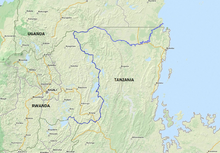
Back Kagerarivier Afrikaans ካጌራ ወንዝ Amharic نهر كاجيرا Arabic Kagera (kuksa) AVK کاقرا چایی AZB Кагера Byelorussian Кагера Bulgarian কাজিরা নদী Bengali/Bangla Kagera BS Riu Kagera Catalan
| Kagera Akagera | |
|---|---|
 The confluence of the Kagera and Ruvubu rivers near Rusumo Falls, Rwanda/Tanzania. | |
 Map of the Kagera River flowing into Lake Victoria. | |
| Location | |
| Country | Burundi |
| Country | Rwanda |
| Country | Tanzania |
| Region | Kagera Region |
| Country | Uganda |
| Physical characteristics | |
| Source | |
| • coordinates | 2°21′18″S 30°22′22″E / 2.35500°S 30.37278°E |
| Source confluence | near Lake Tanganyika |
| • location | Eastern Province, Rwanda |
| Mouth | |
• location | Lake Victoria |
• coordinates | 0°56′41″S 31°46′36″E / 0.94472°S 31.77667°E |
| Length | 597 km (371 mi) |
| Basin size | 59,700 km2 (23,100 sq mi) |
| Discharge | |
| • average | 184 m3/s (6,500 cu ft/s) |
| • maximum | 540 m3/s (19,000 cu ft/s) |
| Basin features | |
| Tributaries | |
| • left | Nyabarongo River |
| • right | Ruvuvu River |

The Kagera River, also known as Akagera River, or Alexandra Nile, is an East African river, forming part of the upper headwaters of the Nile and carrying water from its most distant source.[1]: 167 With a total length of 597 km (371 mi) from its source located in Lake Rweru in Rwanda.
The section of river named Kagera begins in Burundi, flowing out from Lake Rweru. From the lake, it flows east along the Rwanda-Burundi and Rwanda-Tanzania borders to a confluence with the Ruvubu River. The waters of the Kagera are thus provided by two major tributaries, the Nyabarongo of Rwanda, which feeds Lake Rweru, and the Ruvubu of Burundi. It is unknown which of these two feeder rivers is the longer and hence the ultimate source of the Nile. From the confluence, the Kagera flows north along the Rwanda-Tanzania border, over Rusumo Falls and through Akagera National Park. It then takes a turn to the east, following the Tanzania-Uganda border and emptying into Lake Victoria in Uganda. In 1898, Richard Kandt was the first European to reach the source of the Kagera.[2]
The river has featured prominently in the histories of the countries it runs through, particularly Rwanda. In 1894, German Gustav Adolf von Götzen crossed the Kagera at Rusumo Falls, marking the Rwandan colonial era that officially started in 1899. And in 1916, during World War I, the Belgians defeated the Germans, entering Rwanda by the same route. The river gained international notoriety in 1994 for carrying bodies from the Rwandan genocide into Lake Victoria, causing a state of emergency to be declared in areas of Uganda, where these bodies eventually washed up.
- ^ Stanley, H.M., 1899, Through the Dark Continent, London: G. Newnes, ISBN 0486256677
- ^ "Archived copy" (PDF). Archived (PDF) from the original on 2016-03-04. Retrieved 2019-09-21.
{{cite web}}: CS1 maint: archived copy as title (link)